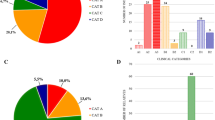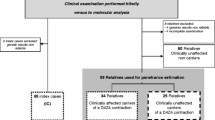Abstract.
There have been few reports on facioscapulohumeral dystrophy (FSHD) without 4q35 deletion. Most of them had either only mild FSHD phenotype or so called "borderline" EcoRI-fragments (35–38 kb). We analysed the clinical, electrophysiological, histological and genetic features of 46 consecutive patients from 31 families with a typical FSHD phenotype. Five patients from three families were identified with unequivocal clinical features of classical Landouzy-Dejerine FSHD, in which no typical FSHD 4q35 deletion could be seen, i. e. fragment sizes were well above 40 kb. Other possible diseases with similar phenotype were excluded. The FSHD gene itself has not been identified so far. The present study suggests that the FSHD phenotype might be caused by different molecular mechanisms.
Similar content being viewed by others
Author information
Authors and Affiliations
Corresponding author
Rights and permissions
About this article
Cite this article
Krasnianski, M., Neudecker, S., Eger, K. et al. Typical facioscapulohumeral dystrophy phenotype in patients without FSHD 4q35 deletion. J Neurol 250, 1084–1087 (2003). https://doi.org/10.1007/s00415-003-0158-5
Received:
Revised:
Accepted:
Issue Date:
DOI: https://doi.org/10.1007/s00415-003-0158-5




